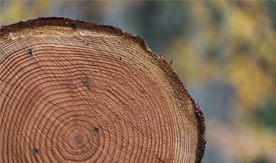
UMaine Students, Researchers Take Part in Weeklong Science Program in Acadia National Park
University of Maine students and researchers will study the science of tree ring dating during a week of hands-on fieldwork in Acadia National Park.
The 25th annual North American Dendroecological Fieldweek (NADEF) runs from June 1–10 at the Schoodic Institute in Winter Harbor. NADEF is funded in part by the National Science Foundation and aims to train students in dendrochronology, or the scientific method of dating based on the analysis of tree ring patterns, during an intensive week of fieldwork, laboratory exercises and lectures.
“The fieldweek educational model is designed around hands-on and applied education,” says Jim Speer, NADEF director and professor of geography and geology at Indiana State University.
Throughout the course, which takes place at a different location every summer, participants experience all aspects of dendrochronology or dendroecology research, from sample collection, preparation and measurement, to data analyses and interpretation, as well as presentation of results.
“It is professional-level work and a very intense experience,” according to Speer, who says the participants complete original research projects, and an average of two of the projects are published each year in peer-reviewed journals.
“We partner with Acadia to attract and develop research and education opportunities, often with the University of Maine and other partners,” says Mark Berry, president and CEO of Schoodic Institute, a nonprofit partner of the National Park Service that manages the Schoodic Education and Research Center campus at Schoodic Point. “Acadia is an outstanding destination for field research, in part because of its long legacy of ecological investigation, and is an inspiring environment for students.”
Forty students from around the country, as well as Canada and India, will take part in the course. Four of the students are from UMaine. While most participants are graduate students, faculty and professional foresters also take part.
“The tree ring record is a biological archive and when properly read, it reveals a history of how our forests have responded to past stressors and disturbances,” says Shawn Fraver, an assistant professor of forest ecosystems science in UMaine’s School of Forest Resources. “These past responses provide insights into the resistance and resilience of Maine’s forests to current and future stressors associated with a changing climate, an increase in extreme weather events, and perhaps a pending spruce budworm outbreak.”
The science of tree ring research is properly referred to as dendrochronology, Fraver says. When applied to ecological problems, the field is sometimes referred to as dendroecology.
The program, which has been run by Indiana State University since 2003, offers six lab groups led by 13 instructors from institutions across the country, each representing a specialty within the field of dendrochronology.
Fraver will co-lead the stand dynamics group with Chris Gentry, an associate professor of geography at Austin Peay State University in Tennessee.
The group will use growth patterns evident in tree rings to reconstruct the history of forest development, including response to past disturbances, such as wind storms and insect outbreaks, in a red spruce forest within Acadia National Park, Fraver says.
Kara Costanza, a UMaine Ph.D. student working with Fraver, will co-teach the introductory dendrochronology group with Neil Toth, an Indiana State University alumnus. The group will likely collect samples from a recently cleared tract of land acquired by Acadia National Park to examine the species composition and develop chronologies.
Other groups include sclerochronology, which will apply dendrochronology techniques to the ear bones of fish and bivalve shells; dendroarchaeology, which will examine the oldest buildings in Acadia to determine construction dates; dendroclimatology, which will develop a chronology and examine climate history in white cedar or older red spruce; and fire history, which will collect samples to examine the park’s historical fire data.
“I hope students will come to appreciate the enormous potential of the tree ring record for addressing today’s pressing environmental issues,” Fraver says.
The week will include one to two full days of fieldwork where participants will collect samples, followed by several laboratory days with evening lectures, and ending with a presentation of projects June 9.
“This international workshop bringing the best scientists working on dendroecology to Acadia is a wonderful example of the opportunities that research learning centers offer for national parks,” says Becky Cole-Will, chief of resource management for Acadia National Park. “The research provides expertise and capacity for scientific research that parks often do not have.”
More information about NADEF is online.
Contact: Elyse Kahl, 207.581.3747
